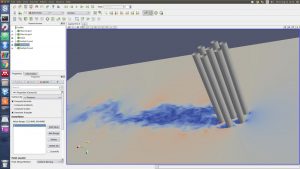Professor Stephen Turnock and Laura Marimon Giovannetti had a busy day on the 7th July talking about the University of Southampton’s experience in engineering excellence in performance sport. Firstly in the afternoon at an event hosted by the Bishop Wordsworth school in Salisbury to an audience of 230 year 10 to year 12 students from four different school’s in the Salisbury area. Then again in a slightly longer format to the IMechE’s Wessex Region as the 11th Annual Arnold Barks Christmas Lecture to an audience of over 100 .
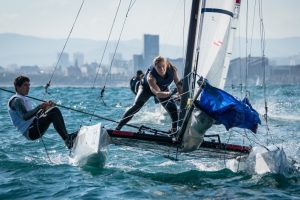
The talk linked the long standing work at Southampton in performance sailing led for nearly five decades by the internationally renowned Wolfson Unit for Marine Technology and Industrial Aerodynamics now based in B185 adjacent to our new 138 m long towing tank, the work on developing F1 and Indy cars in the R.J.Mitchell wind tunnel from the late 70s as well as over a decade of collaboration with UKSport/EIS(R&I) supporting a wide range of sports. The pursuit of performance that ensure that all athletes have the best possible equipment relies on a deep understanding of the physics of the problem coupled to possible engineering solutions. A common thread was the human aspects of the work where able PhD students work alongside sport scientists, coaches and athletes. To date PSEL has graduated 8 EngD/PhD students many of whom have an undergraduate Ship Science degree.
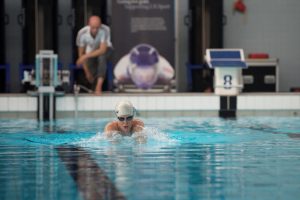
In a final section the relevance of the techniques and technologies developed in performance sport to the wider world and in particular the necessity to find solutions to the essential challenge of improving the energy efficiency of global shipping which transports 90% of the worlds goods, emits 3% of CO2 in 100,000 ships. How will these ships be fuelled in a low carbon world? An example of the cross-over is in Dr Angus Webb whose spin out company Dynamon offers services to the logistics industry.
For both talks the audience asked challenging questions and were in turn asked to spread the word that many more maritime engineering and ship scientists are needed!
Tag Archives: naval architecture
GDP 23: Hydrofoiling Catamaran Experimental Research Platform
In recent years there has been an increasing trend of utilising hydrofoils to reduce drag and enhance the performance of high speed sailing vessels, following the developments of the International Moth class and the AC72s in the 34th America’s Cup. With this current interest growing within the marine industry, it is an exciting opportunity to establish a research platform acting as an interface to effectively carry out experimental testing of innovative hydrofoil technology.
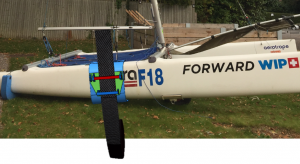
Our aim is to create this research platform by retrofitting a NACRA F18 catamaran using two J-shaped foils to facilitate foiling. In addition, two T-foil rudders will be designed and manufactured from composite materials. A pod system inserted onto the existing daggerboard cases, seen in Fig. 1, will also be developed to attach the J-foils to the side of the boat. The rudders will be designed to have interchangeable wings, allowing for different combinations of main foils and rudder tips to be used. This will permit the investigation into effects of alternative designs. These are the two main features that affect the forces acting on the boat and are therefore very important when developing a foiling craft.

In order to analyse the boat’s response to real world conditions and to collect performance data such as speed, acceleration, roll, rate of turn and foils force, a suitable data acquisition system will also be developed. We aim to provide a good basis for further hydrofoil research to be carried out within the University and hope to encourage more curious minds to pursue naval architecture!
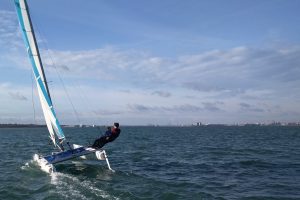
If you want to find out more about the project as it goes forward please visit their facebook page https://www.facebook.com/TheVolantiProject/
Lets twist – how does it influence VIV?
This summer one of our recent MEng graduates Carlos Losada de la Lastra spent a month in Southampton and two in Singapore and reports on his research project in offshore hydrodynamics.

The offshore industry is tending towards multi-riser structures where the offshore platform or floating unit uses more than one pipe to meet more requirements. These pipes have a cylindrical cross section, which may induce vortex induced vibrations (VIV) as crossflow passes around them. This causes fatigue and high loading on the connection points at the seabed and the offshore structure.
The aim of the study was to investigate whether a helical arrangement of the cylinders could reduce the vibrations of the array and provide a wider operational window for offshore structures with multiple risers. I carried out the study using Assoc. Prof. Weymouth’s CFD solver, Lotus, to predict the flow around a seven cylinder array. The main parameters affecting the VIV of the array are, the flow speed, the gap between the cylinders, and the pitch of the array. Where the pitch governs the helicity of the array. To decouple each of the parameters I carried out separate investigations covering each of the parameters.
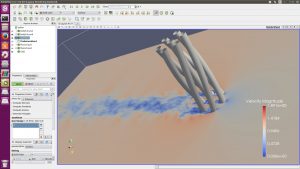
I started the parameter investigation by looking into the effects the gap had on the side force produced by the vortex shedding. I then started investigating the effects of varying the flow speed on the gap range of relevance. Before running simulations of the helical array I had to write a mapping function that twisted it. Having finished writing and validating the mapping function, I looked into the effects of varying the pitch of the array.
The project has been a really good experience. The idea of a helical array came from a question I asked during a lecture last January. This really motivated me throughout the project. The project itself provided a great insight to research. My two supervisors, Assoc Prof. Weymouth and Dr. Vinh Tan, provided invaluable guidance and help throughout the project, but it was up to me to run the simulations, deliver good results and contribute to the discussion. This allowed me both to develop and organise, my simulations, my thought process and my reasoning through the concepts. I learned a lot about hydrodynamics, running and automating simulations, and post processing of results. I also improved my programming and computing skills.

On the cultural side of things I managed to see and experience Singapore with many friends, and squeeze a trip to Bangkok on a weekend as a back packer.

